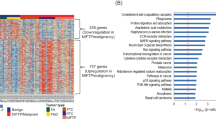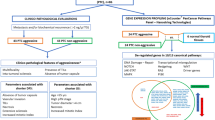Abstract
Identification of multiple clinical and pathologic prognostic factors in differentiated thyroid cancer has permitted some degree of risk stratification. However, these clinical indices fail to distinguish potential intrinsic differences in tumor virulence. The nm23 gene has been identified as a potential metastasis suppressor gene that is homologous to nucleoside diphosphate kinases. Studies in human breast cancer have shown a significant inverse correlation between nm23 levels and nodal involvement/tumor recurrence. Given the possible clinical utility of a marker of metastatic potential in the management of thyroid carcinoma, we examined 34 thyroid neoplasms and a human medullary thyroid cancer (MTC) cell line (TT) for nm23 expression. Normalized nm23 expression was assessed by Northern analysis of tumor RNA. nm23 Expression (tumor expression/TT cell expression, mean ±SE) was 1.14 ±0.15* in MTCs (n =5), 0.70 ±0.10* in follicular cancers (n=6), 0.51 ±0.11 in papillary cancers (n=19), and 0.31 ±0.03 in follicular adenomas (n=4) (*p< 0.05 when compared to adenomas). Within histologicgroups, we found no correlation between nm23 expression and nodal involvement or distant métastases. Our results indicate that thyroid neoplasms of different histologies express varying levels of the nm23 transcript. Although nm23 expression seems diminished in metastatic breast cancer, it appears not to be the case in metastatic thyroid cancer. The nm23 gene may therefore have different roles in the evolution and metastases of different neoplasms.
Résumé
L'identification de facteurs pronostiques clinique et histologique dans le cancer thyroïde permettrait de stratifier les patients selon le risque encouru. Cependant, les indices cliniques ne sont pas toujours fiables en ce qui concerne le potentiel tumoral. Le gène nm23 a été identifié comme un gène de répression de métastase, homologue aux kinases des nucléides diphosphorées. Des études récentes chez la femme ayant un cancer du sein ont démontré un rapport inverse entre les taux de gène nm23 et la présence de métastase ou de récidive ganglionnaire. Etant donnée la valeur potentielle d'un tel marqueur de métastase, nous avons étudié la lignée cellulaire (LC) de 35 patients ayant un cancer de la thyroïde (dont un cancer médullaire (MTC)) pour la présence de nm23. L'expression nm23 a été évaluée par l'analyse Northern du contenu tumoral en ARN. Le rapport expression tumoral/LC (moyen ±ET) a été de 1.14±0.15* dans le MTC, de 0.70±0.10* dans le cancer folliculaire (n=6), de 0.51 ±0.11 dans le cancer papillaire (n= 19) et de 0.31±0.03 dans l'adénome folliculaire (n=4) (*=p <0.05 comparé aux adénomes). A l'intérieur des différents groupes histologiques, aucune corrélation significative n'a été retrouvée entre l'expression nm23 et l'envahissement ganglionnaire ou les métastases à distance. Nos résultats indiquent que les cancers de la thyroïde ont des taux différents de nm23. Alors que l'expression nm23 paraît être diminuée dans le cancer du sein métastatique, cela peut n'être pas vrai pour le cancer de la thyroïde métastatique. La gène nm23 peut donc avoir un rôle différent dans l'évolution et le développement des métastases de cancers différents.*=p<0.05
Resumen
Los pacientes con cancer diferenciado de la glándula tiroides (papilar, folicular, medular) generalmente tienen buen pronóstico a largo plazo. Sin embargo, existen subgrupos de pacientes con un tipo agresivo de neoplasma, quienes desarrollan metástasis sistémicas y eventualmente mueren por causa de su enfermedad.
La identificación de una multitud de factores de pronóstico, clínicos y anatomopatológicos, en el cáncer diferenciado de la tiroides permite un cierto grado de estratificación, aunque tales indicadores no son capaces de diferenciar potenciales variaciones intrînsecas en la virulencia del tumor.
El gen nm 23 ha sido identificado como uno potencialmente supresor de metastasis, el cual es homólogo con las nucléosido difosfato quinasas. Estudios recientes en cancer mamario humano han demostrado una correlación inversa entre los nivelés de nm 23 y la invasión ganglionar/recurrencia tumoral. Considerando la posible utilidad clínica de disponer de un marcador del potencial metastásico en el manejo del carcinoma tiroideo, nos propusimos examinar 34 neoplasmas tiroideos y una línea celular (TT) de cáncer medular de tiroides en cuanto a expresión de nm 23, según el “Northern analysis” del RNA tumoral. La expresión normalizada de nm 23 (expresión tumoral/expresión de células TT, media ±SE) fue 1.14 ±0.15* en los cánceres medulares (n=5), 0.70 ±0.10* en cánceres foliculares (n=6), 0.51 ±0.11 en cánceres papilares (n=19) y 0.31 ±0.03 en adenomas foliculares (n=4) (*=p<0.05 al comparar con adenomas). No se halló correlación entre la expresión de nm 23 y la invasión ganglionar o metástasis distantes dentro de los grupos histológicos. Nuestros resultados indican que los neoplasmas tiroideos de diferentes histologías expresan nivelés variables de la transcription de nm 23. Sin embargo, aunque la expresión de nm 23 parece estar disminuida en el cáncer mamario metastásico, ésto no parece ocurrir en el cancer tiroideo metastásico. Por consiguiente, el gen nm 23 puede jugar diferentes papeles en la evolution y en las metástasis de los diferentes neoplasmas.
Similar content being viewed by others
References
Robbins, J., Merino, M.J., Boice, J.D., Jr., et al.: Thyroid cancer: a lethal endocrine neoplasm. Ann. Intern. Med.115:113, 1991
Cady, B., Rossi, R.: An expanded view of risk-group definition in differentiated thyroid carcinoma. Surgery104:947, 1988
Hay, I.D.: Cytometric DNA ploidy analysis in thyroid cancer. Diagn. Oncol.1:181, 1991
Khosla, S., Patel, V.M., Hay, I.D., et al.: Loss of heterozygosity suggests multiple genetic alterations in pheochromocytomas and medullary thyroid carcinomas. J. Clin. Invest.87:1691, 1991
Herrmann, M.A., Hay, I.D., Bartelt, D.H., Jr., et al.: Cytogenetic and molecular genetic studies of follicular and papillary thyroid cancers. J. Clin. Invest.88:1596, 1991
Fusco, A., Grieco, M., Santoro, M., et al.: A new oncogene in human thyroid papillary carcinomas and their lymphnodal metastases. Nature328:170, 1987
Donghi, R., Sozzi, G., Pierotti, M.A., et al.: The oncogene associated with human papillary thyroid carcinomas (PTC) is assigned to chromosome 10q11–q12 in the same region as multiple endocrine neoplasia type 2A (MEN 2A). Oncogene4:521, 1989
Grieco, M., Santoro, M., Berlingieri, M.T., et al.: PTC is a novel rearranged form of theret proto-oncogene and is frequently detected in vivo in human thyroid papillary carcinomas. Cell60:557, 1990
Karga, H., Lee, J.K., Vickery, A.L., Jr., Thor, A., Gaz, R.D., Jameson, J.L.:Ras oncogene mutations in benign and malignant thyroid neoplasms. J. Clin. Endocrinol. Metab.73:832, 1991
Lemoine, N.R., Mayall, E.S., Wyllie, F.S., et al.: Activated ras oncogenes in human thyroid cancers. Cancer Res.48:4459, 1988
Namba, H., Gutman, R.A., Matsuo, K., Alvarez, A., Fagin, J.A.: H-ras protooncogene mutations in human thyroid neoplasms. J. Clin. Endocrinol. Metab.71:223, 1990
Namba, H., Rubin, S.A., Fagin, J.A.: Point mutations ofras oncogenes are an early event in thyroid tumorigenesis. Mol. Endocrinol.4:1474, 1990
Suarez, H.G., du Villard, J.A., Severino, M., et al.: Presence of mutations in all threeras genes in human thyroid tumors. Oncogene5:565, 1990
Wright, P.A., Lemoine, N.R., Mayall, E.S., et al.: Papillary and follicular thyroid carcinomas show a different pattern ofras oncogene mutation. Br. J. Cancer60:576, 1989
Lemoine, N.R., Mayall, E.S., Wyllie, F.S., et al.: High frequency ofras oncogene activation in all stages of human thyroid tumorigenesis. Oncogene4:159, 1989
Rosengard, A.M., Krutzsch, H.C., Shearn, A., et al.: Reduced nm23/awd protein in tumor metastasis and aberrantDrosophila development. Nature342:177, 1989
Steeg, P.S.: Search for metastasis suppressor genes. Invasion Metast.9:351, 1989
Bevilacqua, G., Sobel, M.E., Liotta, L.A., Steeg, P.S.: Association of low nm23 RNA levels in human primary infiltrating ductal breast carcinomas with lymph node involvement and other histopathologic indicators of high metastatic potential. Cancer Res.49:5785, 1989
Hennessy, C., Henry, J.A., May, F.E.B., Westley, B.R., Angus, B., Lennard, T.W.J.: Expression of the antimetastatic gene nm23 in human breast cancer: an association with good prognosis. J. Natl. Cancer Inst.83:281, 1991
Barnes, R., Masood, S., Barker, E., et al.: Low nm23 protein expression in infiltrating ductal breast carcinomas correlates with reduced patient survival. Am. J. Pathol.139:245, 1991
Steeg, P.S., Bevilacqua, G., Kopper, L., et al.: Evidence for a novel gene associated with low tumor metastatic potential. J. Natl. Cancer Inst.80:200, 1988
Leong, S.S., Horoszewicz, J.S., Shimaoka, K., et al.: A new cell line for study of human medullary thyroid carcinoma. In Advances in Thyroid Neoplasm, M. Andreoli, F. Monaco, J. Robbins, editors. Rome, Field Educational Italia, 1981, pp. 95–108
Cathala, G., Savouret, J.R., Mendez, B., et al.: A method for isolation of intact, translationally active ribonucleic acid. DNA2:329, 1983
Gunning, P., Ponte, P., Okayama, H., Engel, J., Blau, H., Kedes, L.: Isolation and characterization of full length cDNA clones for human alpha-, beta-, and gamma-actin mRNAs: skeletal but not cytoplasmic actins have an aminoterminal cysteine that is subsequently removed. Mol. Cell. Biol.3:787, 1983
Steeg, P.S., Cohn, K.H., Leone, A.: Tumor metastasis and nm23: current concepts. Cancer Cells3:257, 1991
Khokha, R., Waterhouse, P., Yagel, S., et al.: Antisense RNAinduced reduction in murine TIMP levels confers oncogenicity on Swiss 3T3 cells. Science243:947, 1989
Galtoni-Celli, S., Marozzi, A., Timpane, R., Kirsch, K., Isselbacher, K.J.: Partial suppression of metastatic potential of malignant cells in immunodeficient mice caused by transfection of the H-2Kb gene. J. Natl. Cancer Inst.82:960, 1990
Pozzatti, R., Muschel, R., Williams, J., et al.: Primary rat embryo cells transformed by one or two oncogenes show different metastatic potentials. Science232:223, 1986
Liotta, L.A., Steeg, P.S.: Clues to the function of nm23 and awd proteins in development, signal transduction, and tumor metastatsis provided by studies ofDictyostelium discoideum. J. Natl. Cancer Inst.82:1170, 1990
Leone, A., Flatow, U., King, C.R., et al.: Reduced tumor incidence, metastatic potential, and cytokine responsiveness of nm23transfected melanoma cells. Cell65:25, 1991
Nakayama, T., Ohtsura, A., Nakao, K., et al.: Expression in human hepatocellular carcinoma of nucleoside diphosphate kinase, a homologue of the nm23 gene product. J. Natl. Cancer Inst.84:1349, 1992
Haut, M., Steeg, P.S., Willson, J.K.V., Markowitz, S.D.: Induction of nm23 gene expression in human colonicneoplasms and equal expression in colon tumors of high and low metastatic potential. J. Natl. Cancer Inst.83:712, 1991
Hailat, N., Keim, D.R., Melhem, R.F., et al.: High levels of p19/nm23 protein in neuroblastoma are associated with advanced stage disease and withN-myc gene amplification. J. Clin. Invest.88:341, 1991
Keim, D., Hailat, M., Melhem, R., et al.: Proliferation-related expression of p19/nm23 nucleoside diphosphate kinase. J. Clin. Invest.89:919, 1992
Stahl, J.A., Leone, A., Rosengard, A.M., Porter, R., King, C.R., Steeg, P.S.: Identification of a second human nm23 gene, nm23-H2. Cancer Res.51:445, 1991
Sambrook, J., Fritsch, E.F., Maniatis, T.: Molecular Cloning. Cold Spring Harbor, NY, Cold Spring Harbor Laboratory Press, 1989, pp. 11.11–11.15
Author information
Authors and Affiliations
Rights and permissions
About this article
Cite this article
Farley, D.R., Eberhardt, N.L., Grant, C.S. et al. Expression of a potential metastasis suppressor gene (nm23) in thyroid neoplasms. World J. Surg. 17, 615–620 (1993). https://doi.org/10.1007/BF01659123
Issue Date:
DOI: https://doi.org/10.1007/BF01659123




